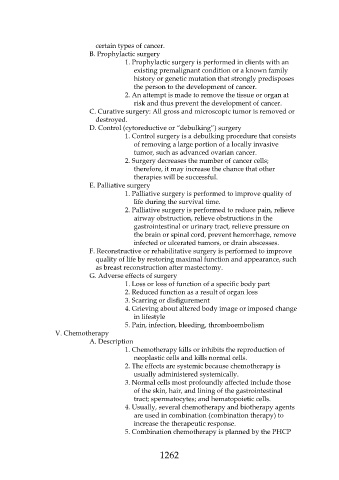Page 1262 - Saunders Comprehensive Review For NCLEX-RN
P. 1262
certain types of cancer.
B. Prophylactic surgery
1. Prophylactic surgery is performed in clients with an
existing premalignant condition or a known family
history or genetic mutation that strongly predisposes
the person to the development of cancer.
2. An attempt is made to remove the tissue or organ at
risk and thus prevent the development of cancer.
C. Curative surgery: All gross and microscopic tumor is removed or
destroyed.
D. Control (cytoreductive or “debulking”) surgery
1. Control surgery is a debulking procedure that consists
of removing a large portion of a locally invasive
tumor, such as advanced ovarian cancer.
2. Surgery decreases the number of cancer cells;
therefore, it may increase the chance that other
therapies will be successful.
E. Palliative surgery
1. Palliative surgery is performed to improve quality of
life during the survival time.
2. Palliative surgery is performed to reduce pain, relieve
airway obstruction, relieve obstructions in the
gastrointestinal or urinary tract, relieve pressure on
the brain or spinal cord, prevent hemorrhage, remove
infected or ulcerated tumors, or drain abscesses.
F. Reconstructive or rehabilitative surgery is performed to improve
quality of life by restoring maximal function and appearance, such
as breast reconstruction after mastectomy.
G. Adverse effects of surgery
1. Loss or loss of function of a specific body part
2. Reduced function as a result of organ loss
3. Scarring or disfigurement
4. Grieving about altered body image or imposed change
in lifestyle
5. Pain, infection, bleeding, thromboembolism
V. Chemotherapy
A. Description
1. Chemotherapy kills or inhibits the reproduction of
neoplastic cells and kills normal cells.
2. The effects are systemic because chemotherapy is
usually administered systemically.
3. Normal cells most profoundly affected include those
of the skin, hair, and lining of the gastrointestinal
tract; spermatocytes; and hematopoietic cells.
4. Usually, several chemotherapy and biotherapy agents
are used in combination (combination therapy) to
increase the therapeutic response.
5. Combination chemotherapy is planned by the PHCP
1262

